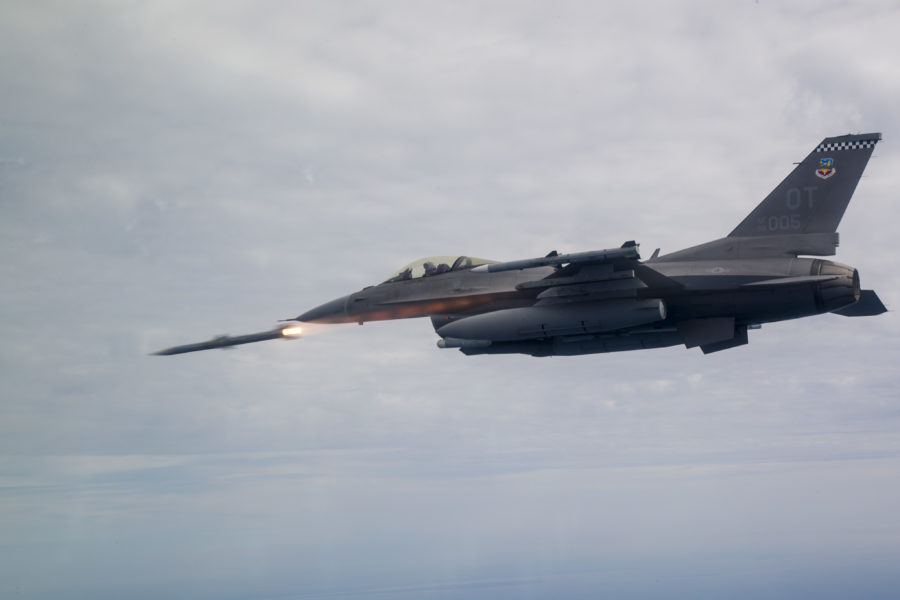Maj. Gen. Larry Stutzriem, USAF (Ret.) is the director of research at Mitchell Institute for Aerospace Studies. He is a veteran fighter pilot and commander, with time in the F-4, F-16, and A-10. He directed combat operations in Afghanistan and Iraq.
On June 9, 1982, Israeli Air Force (IAF) combat aircraft flew into the jaws of one of the most heavily fortified air defense regions on the globe—Lebanon’s Beqaa Valley. Packed with Soviet-built, Syrian-owned surface-to-air missiles (SAMs), anti-aircraft artillery (AAA), and air defense fighters, defense experts deemed it impenetrable. Yet within two hours, nearly all the Syrian air defenses lay in ruins and Israeli combat aircraft owned the sky.
Four decades later, the lessons of that faceoff hold priceless lessons for Ukraine—especially now that Western powers have finally agreed to provide modern combat aircraft.
Until now, U.S. military leaders have maintained that Russian air defenses are effectively impenetrable by fourth-generation jets like the F-16. In reality they can be defeated—albeit at high risk. Circumstances facing the Ukrainians warrant taking that risk. However, the approach to executing these missions is far more complex than merely adding airframes.
No one is advocating Ukraine fly F-16s blindly into the Russian defenses. Effective use of airpower requires a mix of strategy, tactics, capabilities, and technology to net desired effects. Subject to an effective, integrated attack, even a robust air defense like Russia’s has vulnerabilities. It comes down to the right mix of operational concepts properly executed through an orchestration of warfighting capabilities. This is what comprises an integrated air campaign—and exactly what made the IAF successful in 1982.
To exploit weaknesses in the Soviet-built, Syrian-operated air defenses in the Beqaa Valley, the IAF’s integrated attack incorporated U.S. designed F-15, F-16, and F-4 fighter aircraft, Israeli unmanned aerial vehicles (UAVs), decoys, electronic attack systems, battle management, and more. The IAF exploited gaps and seams in the Syrian defenses, using their intelligence and knowledge of those seams to project power precisely at the right time and place, thus degrading the enterprise. Then came the knock-out blow, when fighter aircraft destroyed all 19 SAM sites. The defenses were not an impossible operational challenge. There were varying points of strength and weakness. The IAF focused on the latter.
Since then, Russia has significantly improved its integrated air defenses. Russian SAMs are still viewed as the best in their class. This is why the United States and its allies are investing so aggressively in new fifth-generation combat aircraft, like the F-35 and B-21. These low-observable aircraft offer a huge advantage over integrated air defenses, and in future conflict, the U.S. will need those next-generation capabilities. But in its war with Russia now, Ukraine does not have that option. Smaller and less well-resourced than Russia, Ukraine must work within the art of the possible, despite the risks. Without modern fighter jets and other capabilities associated with air campaign design, Ukrainians face a slow death in a war of attrition they cannot sustain.
Degrading Russian air defenses is a major step in establishing air superiority that will enable Ukraine to rise above the trenches and barriers to allow fighter jets to attack Russian forces, facilities, logistics, and communications within Ukraine.
Take note that China and other adversaries are watching. Ukraine’s willingness to challenge Russian air defenses has parallels with the U.S. and its allies. By supporting Ukraine, we send the signal that we too will not give up when challenged by ground-based air defenses.
While Russian air defenses pose a significant threat, they also have significant weaknesses. Ukraine can exploit these, including Russia’s poorly trained conscription force. Russian President Vladimir Putin entered the war with known personnel deficiencies; battlefield attrition has further diluted available talent. Additionally, Russia’s defenses are networked. Those links can be attacked.
Ukraine has several types of unmanned, loitering aircraft and munitions. These are incredibly useful for projecting surveillance, sensing, and striking power at low risk. More sophisticated unmanned attacks can be waged by larger reusable UAVs, like the MQ-9 Reaper or MQ-1C Gray Eagle. Some may get shot down, but many will succeed in executing their strikes as part of an integrated air campaign—particularly if they are equipped with modern electronic countermeasures pods.
Regardless, any SAM expended against or destroyed by UAVs cannot be used against manned aircraft. The aim is to place the air defense network under significant stress that suppresses and degrades its effectiveness. This allows windows of opportunity for manned combat aircraft, like F-16s, which are capable of complex operations required to eliminate Russian offensive capabilities.
In a war for survival, Ukraine needs every weapon it can bring to the fight. There comes a point where Putin’s stockpiles will deplete. Russia cannot afford to sacrifice its entire IADS capacity in Ukraine—they have many more borders to defend.
The U.S. must stay the course in supporting the rapid transfer of Western combat aircraft and associated weapons. The sooner the U.S. transfers both manned and unmanned combat aircraft, the greater advantage Ukraine can gain over Putin’s forces. Also crucial are training for both pilots and maintainers, plus ample flows of spare parts and munitions. Ukraine must have both the ability to fight and to sustain the fight.
When I joined the U.S. Air Force in the wake of the Vietnam War, the experienced combat pilots who trained me had flown in some of the most challenging threat environments ever constructed. Despite heavy losses and challenging odds, those airmen were successful because they never stopped innovating in the face of a skilled opponent. That’s what the IAF did in 1982.
It’s what Ukraine must do now. The West is right to give them the aircraft and weapons they need—the tools to fight the war they’ve been forced to fight. Let the training begin, and let Ukraine take the war to its enemy.
